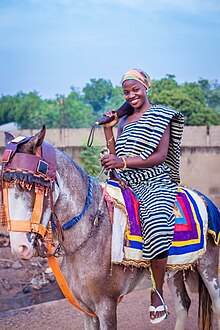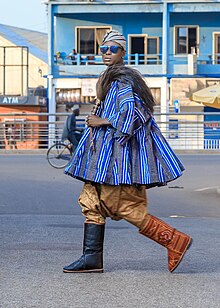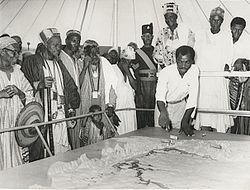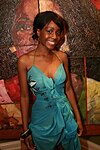| Dagbamba | |
|---|---|
 | |
| Total population | |
| 3.1 million | |
| Regions with significant populations | |
| Kingdom of Dagbon (northern Ghana) | |
| Languages | |
| Dagbani, English, French | |
| Religion | |
| Sunni Islam, minority Christianity | |
| Related ethnic groups | |
| Mossi, Mamprusi, Frafra, Gurunsi, other Gur peoples |
| People | Dagomba |
|---|---|
| Language | Dagbani |
| Country | Dagbon |
The Dagbamba or Dagomba are an ethnic group of Ghana, and Togo. They number more than 3.1 million people. The term Dagbamba is originally extended to refer to other related peoples who were unified by Naa Gbewaa including the Mamprusi and Nanumba. The Dagomba country is called Dagbon and they speak Dagbanli language. Dagbanli is the most spoken language of northern Ghana and second most widely spoken local language of Ghana. Dagbanli belongs to the Mabia (Mole-Dagbani) subgroup of the Gur languages, a large group of related languages in West Africa. The Dagomba practises both patrilineal and matrilineal systems of inheritance.
In the late 1600s, King Zanjina, became the first ruler to practise Islam. The reign of Zanjina ushered in an era of greater prosperity. Many learning centres were established and scholarship became an important part of tradition. In 1700, the University Moliyili was established, but was later abandoned during European colonization. The Dagomba resisted European Colonization even after Germany burnt down and occupied its capital, Yendi, located in Eastern Dagbon (Naya).
The Dagomba are one of few African people who reserve royal titles for women. Dagomba women rule, ascend to royal positions with male subjects, and own regal lands. The impact of its women is prominent as it has given birth to Ghana's first female minister, and Africa's first female cabinet minister. Historically, its noble daughter, Yennenga, is regarded as the "mother" of the Mossi kingdoms, a people who constitute nearly half of the nation of Burkina Faso. The Gundo Naa is the head of all female chiefs, and the Zosimli Naa enhances collaboration between cities of Dagbon and sister cities.
The Dagombas established several schools prior to European arrivals in Africa. A later but more known institution is the University of Moliyili, established in 1700. Moliyili had a hierarchical scholastic system similar to what is found in modern universities. The Dagomba have a writing system, the Dagbani script, which uses a modified Arabic alphabet but Dagbani syntax. The archival manuscripts have been lost, but many transferred to Denmark. After joining Gold Coast as a protectorate (not colony), the Dagombas adopted the Greek and Latin alphabets.
Women are held in high regard, and children fear the displeasure and wrath of the mother. Brothers protect the dignity of sisters at all cost. The Dagombas are one of the few peoples in Africa to have female chiefs who possess regal lands and rule over male subjects. Closest family bonds are termed "Mabihili". Both males and females in such a close family bond refer to each other as Mabia (mother's child), signifying the importance of the mother. Motherland is termed Mayili and fatherland is termed Bayili. There is no English equivalent of Mabihili.
In Dagomba society, there are several gods (singular: wuni, plural: wuna). The chief (Naa) of all these gods is Naawuni. Each city has a shrine (buɣli). For example, the shrine of the People of Tolon is Jaagbo, and that of Nyankpala is Wonoyili. There are many soothsayers (baɣa) whom people consult for prophesies and solutions to their problems. The inheritance of many soothsaying is through a maternal brother.
Many Christian evangelical groups have launched failed campaigns to convert the Dagomba. However, the Dagomba continue practising its traditional religion and Islam. The arrival of Islam to the Dagomba brought prosperity, whiles, Christianity was brought by Europeans, who burnt their cities and displaced its people. Today, the Dagomba have provided free lands to many Christian missionaries to undertake their activities. While Islamic schools do not mandate students to worship or visit mosques, Christian schools makes worship compulsory for all students, even for members of the Dagbon Traditional Religion and Islam.
The Dagombas celebrate the oldest festivals in Ghana, including the Fire Festival, which existed prior to the formation of the Kingdom of Dagbon. Other festivals include the Damba Festival, Guinea Fowl (Kpini Chuɣu) Festival and Yam Festival (Nyuli Dibu), Konyuri Chuɣu (Eid Al-Fitr), Chimsi Chuɣu (Eid AL-Adha). Other minor localized festivals that are celebrated included the Market Festival (Daa Chuɣu) by the people of Tolon.
The Dagomba founded the Kingdom of Dagbon. They are historically related to the Mossi people of Burkina Faso. The Mossi Kingdoms were founded by Yennenga, a daughter of Naa Gbewaa. The Mohi/Mossi have their homeland in central Burkina Faso. Aside the Mossi, the Dagombas are the founders of the Bouna state of the Ivory Coast, and the Dagaaba states of Upper West Region of Ghana. The homeland of the Dagomba, Dagbon, covers about 20,000 km in area.
Naa Gbewaa is the founder of the Dagbon Kingdom. Earlier Dagombas prior to Naa Gbewaa lived in decentralized states. Gbewaa, and his descendants, centralized the kingdom. The decentralized states were headed by the Tindaamba. Today, the Tindaamba still preserve the ancient Dagbon traditions that have been passed through the ages, leading traditional religious acts and solving problems of their constituents. The Tindaamba are not appointed by the Yaa Naa, they are chosen by an oracle. Inheritance is both patrilineal and matrilineal. Royalty in Dagbon is complex as it has evolved through the centuries. Dagomba are one of the ethnic groups with a sophisticated oral tradition woven around drums and other musical instruments. Thus, Dagbon history has been passed down meticulously via oral tradition, with drummers as professional griots known as Lunsi. According to oral tradition, the political history of Dagbon has its origin in the life story of a legend called Tohazie (translated as "red hunter").
Dagombas practise both Islam and the Dagbon Traditional Religion. Islam was brought to the region by Soninke (known as Wangara by Ghanaians) traders between the 12th and 15th centuries. Since the time of Naa Zanjina, Islam has been the state religion and Islam seems to be growing rapidly ever since. The reformist activities of Afa Ajura in the middle of the twentieth century caused entire communities to embrace the Islamic religion en masse. Inheritance in the Dagomba people is largely patrilineal, however, inheritance of certain Tindaamba is matrilineal. There are also female rulers with male subordinates, such as the Gundo Naa and the Kpatu Naa. The Gundo Naa has vast land and head all female royals of Dagbon. Important festivals include the Damba, Bugum (fire festival) and the Islamic Eid festivals. The largest settlement of the Dagomba is Tamale, Ghana's third populous and the Northern Region's capital.


The Mossi and Dagomba states are among the great West African medieval empires. Beginning in the 12th century, they eventually ruled the lands of the entire northern Volta basin, which today includes all of northern Ghana and Burkina Faso. During their second northern expansion, the Mossi invasion reached eastern Maasina and Lake Débo c. 1400, Benka in c. 1433 and Walata in 1477-83 (these empires were in present-day Mali). According to Illiasu (1971) in his work The Origins of the Mossi-Dagomba states, the second period of the Mossi-Dagomba success came to an end with the restoration of Imperial Songhai power towards the close of the 15th century. Although the Mossi-Dagomba states have the same grandfather (Naa Gbewa), the Dagomba are traditionally regarded as "senior" to the Mossi states of Ouagadougou, Yatenga and Fada N'Gourma.
Origins

The Dagombas have inhabited Northern for thousands of years. Some members of the ruling class descended from Naa Gbewaa, whose ancestors migrated from around the areas of Lake Chad after the break up of the Ghana Empire at the end of the 13th Century. Gbewaa unified the Dagomba people into a kingdom. Chiefs who are descendants of Gbewaa are the Nanima (singular: Naa) and aboriginal chiefs are the Tindaamba (singular: Tindana). Other important chiefs such the chiefs of Tolon, Kumbungu and Gulkpeɣu (Tamale) may not be descendants of Gbewaa.
Kingdom of Dagbon
Main article: Kingdom of DagbonThe homeland of the Dagombas is called Dagbon and covers about 20,000 km in area. The territories of Dagbon was decentralised until the Great Unification by the Nanima. The Dagomba share close bonds with related people whose lands were also unified. This include the Mamprusi, Nanumba, Gonja, Mossi, Gurunsi (in particular the Frafra and Kusasi peoples), the Wala people and Ligbi. The area constitutes fourteen administrative districts in present-day Ghana. These are the Tamale Metropolitan, Yendi, Savelugu and Sagnerigu municipals, and Tolon, Kumbungu, Nanton, Gushegu, Karaga, Zabzugu, Saboba, Sang, Tatale and Cheriponi districts. The king of the Dagbon Traditional Kingdom is the Ya-Na, whose court and administrative capital is at Yendi. Dagbon as a kingdom has never been subjugated until it was incorporated as a territory of the Gold Coast government. The Dagbon Kingdom has traditional administrative responsibilities hitherto acephalous groups like the Konkomba, Bimoba, Chekosi, Basaari, Chamba, Wala, Gurusi and Zantasi. The Dagombas have cordial and respectful relationships to these groups. The seat of the Yaa Naa or king of Dagbon (literally translated as "King of Absolute Power") is a collection of lion and cow skins. Thus, the Dagbon or its political system is often called the Yendi Skin (not throne or crown or stool). Another characteristic of the Dagomba is that their houses are arranged in a certain order, where the chief or elderly man has his hut built in the centre.
Chieftaincy
One of the major features of Dagomba society is chieftaincy. Their system of chieftaincy is very hierarchical, with the Yaa Naa, or paramount King, at its head and a tiered system of rulers below him. In Dagbon, chiefs traditionally sit on a stack of skins.
Dagomba Festivals
The people of Ghana's Dagbon Kingdom celebrate a number of festivals. Festivals held in Dagbon include the Bugum festival (fire festival), Damba, and Kpini (festival of Guinea fowl). Additionally, there is the Chimsi festival and Konyuri chuɣu (Festival of Breaking the Fast).
Bugum festival (fire festival)
Bugum Festival also known as the Fire festival is an occasion where families gather for communal celebrations, rituals, and joy at the Fire festival in order to honor their ancestors, ask for blessings, and ward off evil spirits. Many different ethnic groups in Northern Ghana celebrate this festival. Most attendees of the festivity are both Muslims and non-Muslims. Muslims celebrate the fire festival, known as Bugum, to commemorate the arrival of Prophet Noah's (Nuhu) Ark following the flood. During the night, bundles of grass are utilized as torches to celebrate. Since the celebration brings in a new year, some non-Muslims use this time to give sacrifices to God and their ancestors.
Notable Dagombas
 Samata Angel
Samata Angel Abdul Majeed Waris
Abdul Majeed Waris Rocky Dawuni
Rocky Dawuni Aliu Mahama
Aliu Mahama Sherifa Gunu
Main article: List of people from Dagbon
Sherifa Gunu
Main article: List of people from Dagbon
- Yakubu II - Former King of Dagbon.
- Aliu Mahama - Former Vice President of Ghana from 2000 to 2008.
- Haruna Yakubu - A past Vice Chancellor of University for Development Studies.
- Haruna Iddrisu - A Ghanaian politician.
- Mubarak Wakaso - A Ghanaian football player
- Abdul Fatawu Issahaku - A Ghanaian football player
- Afa Ajura - founder and leader of the Ahlus Sunnah wal Jamaa'a Islamic sect in Ghana
- Abdul Razak Alhassan - MMA fighter
- Fawaz Aliu
- Abibata Shanni Mahama
- Mohammed Amin Adam
- Hassan Tampuli
- Ibrahim Murtala Mohammed
- Habib Iddrisu
- Alhassan Suhuyini
- Farouk Aliu Mahama
- Abdul-Aziz Ayaba Musah
See also
- List of people from Dagbon
- List of rulers of the Kingdom of Dagbon
- Dagbani language
- Moore language
- Bugum Chugu (Fire Festival in Dagbon)
- Mossi people
- Naming customs of the Dagomba people
References
- "Ghana Population 2019".
- "Dagomba | people". Encyclopedia Britannica. Retrieved 2020-05-24.
- Staniland, Martin, ed. (1975), "The country and the people", The Lions of Dagbon: Political Change in Northern Ghana, African Studies, Cambridge: Cambridge University Press, pp. 1–12, ISBN 978-0-521-10143-1, retrieved 2023-10-22
- Lentz, Carola (1994). "A Dagara Rebellion against Dagomba Rule? Contested Stories of Origin in North-Western Ghana". The Journal of African History. 35 (3): 457–492. ISSN 0021-8537.
- "About the Dagomba".
- "The Dagomba history: the Dagbon kingdom". Exploring Africa. 2018-05-09. Retrieved 2023-10-22.
- Refugees, United Nations High Commissioner for. "Refworld | Ghana: 1) Information on chieftaincy succession among the Dagomba tribe and whether chieftancy is transferred paternally or maternally; 2) Information on the death of the king/chief of the Dagomba in the northern region of Kandiga Sarigu and on his successor". Refworld. Retrieved 2023-10-12.
- "2-11: Naa Zanjina". www.adrummerstestament.com. Retrieved 2023-10-12.
- ^ "SCIENCE AND TECHNOLOGY IN 18TH CENTURY MOLIYILI (DAGOMBA) AND THE TIMBUKTU INTELLECTUAL TRADITION".
- ^ "Depreciating African Political Culture".
- "Yendi's German Cemetery: Resting place for fallen soldiers in Dagbon battle".
- "German Colonialism in West Africa: Implications for German-West African Partnership in Development | H-Soz-Kult. Kommunikation und Fachinformation für die Geschichtswissenschaften | Geschichte im Netz | History in the web". H-Soz-Kult. Kommunikation und Fachinformation für die Geschichtswissenschaften (in German). 2023-10-12. Retrieved 2023-10-12.
- "Female Chiefs in Dagbon Traditional Area: Role and Challenges in the Northern Region of Ghana" (PDF). International Journal of Sociology and Anthropology Research.
- Mohammed, Yakubu; Alhassan, Eliasu; Sayibu, Mahama Seth (2022). "Female Chiefs in Dagbon Traditional Area: Role and Challenges in the Northern Region of Ghana" (PDF). International Journal of Sociology and Anthropology Research. 10 (2): 57–81. ISSN 2059-1209.
- "Role of Female Chiefs in Dagbon Traditional Area". Art + Feminism. Retrieved 2023-09-18.
- "Female Chiefs in Dagbon; Gundo Naa holds their authority and influence". Sanatu Zambang. 2020-01-14. Retrieved 2023-09-18.
- "January 17, 1997: Ghana's first woman minister, Mrs Susanna Al-Hassan passes away". Edward A. Ulzen Memorial Foundation. 2018-01-17. Retrieved 2023-09-18.
- "Meet Susan Alhassan, the first Ghanaian woman to be appointed minister". GhanaWeb. 2023-03-05. Retrieved 2023-09-18.
- "Meet Susanna Al-Hassan, Africa's first female cabinet minister". www.myinfo.com.gh. 2023-03-04. Retrieved 2023-09-18.
- "January 17, 1997: Ghana's first woman minister, Mrs Susanna Al-Hassan passes away". Edward A. Ulzen Memorial Foundation. 2018-01-17. Retrieved 2023-09-18.
- "Yennenga: Ancestor of Burkina Faso's Mossi people – DW – 05/12/2021". dw.com. Retrieved 2023-09-18.
- "YENENGA, The Dagomba Princess". africaaccessreview.org. Retrieved 2023-09-18.
- "Princess Yennenga | Mother of the Mossi". On The Shoulders of Giants. Retrieved 2023-09-18.
- Robicon (2023-09-30). "Sister Cities Tamale calls on Gulkpe Naa to investigate Zosomli Naa's auctioned medical supplies case". RADIO | TAMALE. Retrieved 2023-10-17.
- "Cultivating Empowerment and Leadership in women and girls has always been my focus, Zosimli Naa II". Zaa Radio 99.3 FM. 2022-12-01. Retrieved 2023-10-17.
- "Dagbanli Ajami and Arabic Manuscripts of Northern Ghana". open.bu.edu. Retrieved 2023-10-12.
- "Language resources Dagbani - Language Links Database". The Universe Of Memory. Retrieved 2023-10-17.
- "Dagbani language and alphabet". www.omniglot.com. Retrieved 2023-10-17.
- "Female Chiefs of Dagbon by Eric Gyamfi". Documenting Ghana. 2018-10-19. Retrieved 2023-10-12.
- "Gendered Language as an Obscured Causal Factor of the Dagbon Chieftaincy Conflict in Northern Ghana" (PDF).
- "Spiritual Foundations of Dagbamba Religion and Culture" (PDF).
- "2-19: The Dagbamba Belief in God". www.adrummerstestament.com. Retrieved 2023-10-12.
- "WUNI - the Dagomba God of Creation (African mythology)". Godchecker - Your Guide to the Gods. Retrieved 2023-10-12.
- "EXPLORING LOCAL BELIEF SYSTEMS FOR THE BENEFIT OF LAND RESTORATION: A CASE STUDY OF THE JAAGBO SHRINE RESTORATION IN THE TOLON/KUMBUNGU DISTRICT OF NORTHERN REGION, GHANA" (PDF).
- "Jachie and Jaagbo Groves of Ghana". Sacred Land. Retrieved 2023-10-12.
- ^ "Spiritual Foundations of Dagbamba Religion and Culture" (PDF).
- "Understanding the Folk Islam of the Dagbani-Speaking People: a".
- "THE BEGINNINGS OF CATHOLIC EVANGELIZATION IN TAMALE ARCHDIOCESE". Archdiocese of Tamale. Retrieved 2023-10-12.
- "ISLAM, POLITICS AND DEVELOPMENT: NEGOTIATING THE FUTURE OF DAGBON".
- Davis, David C. (1996). "The Mosque and the Marketplace: An Eighteenth Century Islamic Renaissance in West Africa". Islamic Studies. 35 (2): 135–163. ISSN 0578-8072.
- "German Colonialism in West Africa: Implications for German-West African Partnership in Development".
- Staniland, Martin, ed. (1975), "Dagomba divided and united, 1899–1930", The Lions of Dagbon: Political Change in Northern Ghana, African Studies, Cambridge: Cambridge University Press, pp. 57–77, ISBN 978-0-521-10143-1, retrieved 2023-10-12
- "About the Dagomba – Dagomba Dance Drumming". Retrieved 2023-10-12.
- "Bouna | African kingdom | Britannica". www.britannica.com. Retrieved 2023-10-12.
- Abdallah, Zablong Zakariah; Locke, David (2010). "The Lunsi (drummers) of Dagbon: tradition and change". Research Review (21). ISSN 0855-4412.
- St.John Parsons, D. 1968, Legends of Northern Ghana. London : Longmans.
- A. K. Awedoba; Edward Salifu Mahama; Sylvanus M. A. Kuuire; Felix Longi (October 20, 2010). An Ethnographic Study of Northern Ghanaian Conflicts: Towards a Sustainable Peace. Sub-Saharan Publishers; revised edition. ASIN 9988647387.
- Zakaria, A. B. "Migrant Chiefs in Urban Ghana: The Case of the Dagomba Chiefs in Accra".
- "Virtual Kollage: The pre-colonial political organization of the Mole-Dagbani ethnic group of Ghana". www.virtualkollage.com. Retrieved 2019-10-18.
- "2-5: The Yaa-Naa and the Yendi Elders". www.adrummerstestament.com. Retrieved 2023-10-22.
- "ENSKINMENT OF "TENDAMBA" AND ITS IMPLICATIONS" (PDF).
- "dagomba | About the Dagomba". Retrieved 2020-05-24.
- "Dagomba Festivals • Dagbon Kingdom: Your Gateway to the Best of Culture, History & Tourism". 2023-06-28. Retrieved 2024-04-14.
- Malik (2021-08-15). "Bugum Festival: History of the Fire Festival & How It is Celebrated". Retrieved 2024-04-14.
- "History of the Fire (Bugum) Festival « PAMBE Ghana". pambeghana.org. Retrieved 2024-04-14.
External links
 Media related to Dagomba people at Wikimedia Commons
Media related to Dagomba people at Wikimedia Commons
| Ethnic groups in Ghana | |
|---|---|
| Indigenous | |
| Non-indigenous | |
| Geography |
| ||||||||||||||
|---|---|---|---|---|---|---|---|---|---|---|---|---|---|---|---|
| Linguistics (Language) | |||||||||||||||
| Misplaced Pages | |||||||||||||||